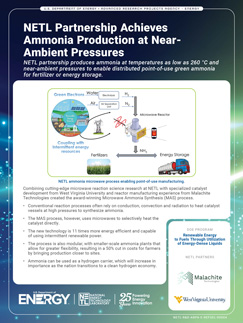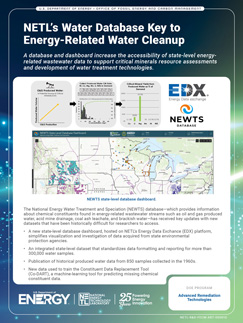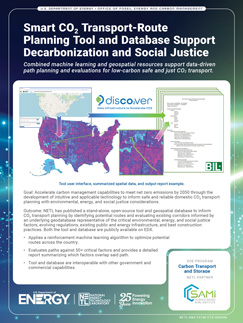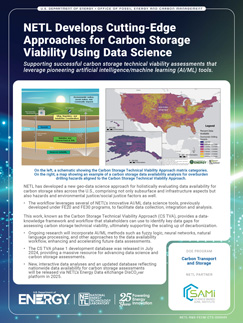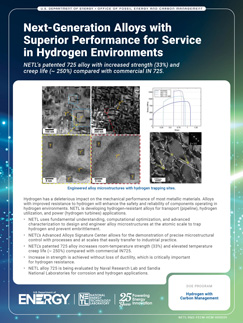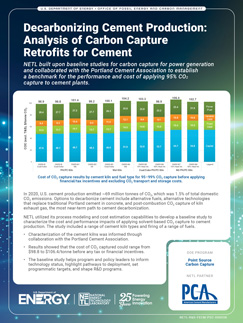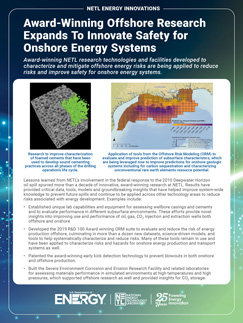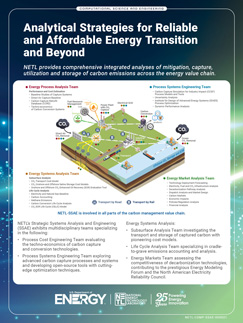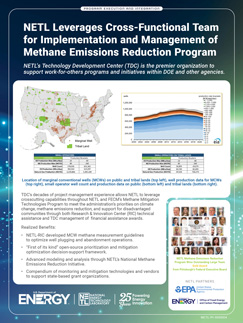NETL Celebrates 25 Years

2024 marks the National Energy Technology Laboratory’s (NETL) 25th anniversary as a U.S. Department of Energy national lab. On Dec. 10, 1999, U.S. Secretary of Energy Bill Richardson signed documents elevating the Federal Energy Technology Center to national lab status and renaming it to the National Energy Technology Laboratory. Over the last 25 years, NETL has made many discoveries that have created impact across the technological spectrum.
Explore our accomplishments and milestones over the past quarter century in the resources below.
25th Anniversary Celebration
Celebrating 25 Years Powering Energy Innovation
Want to learn more about our history before we became a national lab? Check out our history timeline that highlights advancements in energy research from NETL and its predecessor facilities: https://netl.doe.gov/about/history.
A look back – 25 Accomplishments from the last 25 Years
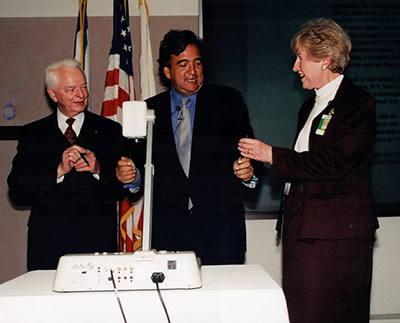
On Dec. 10, 1999, Secretary of Energy Bill Richardson (center) signed documents elevating the Federal Energy Technology Center to national lab status.

NETL prepares the next generation of research talent. For instance, in 2015, NETL hosted 34 Mickey Leland Energy Fellowship (MLEF) interns between June and August, becoming the largest recipient of MLEF interns across the DOE system at the time.

NETL has earned numerous awards for research excellence in the past 25 years. Accolades include R&D 100 recognition for the Offshore Risk Modeling Suite to address key knowledge gaps and improve oil spill prevention methods.

Enabled by NETL project oversight and equipment, a research vessel docked in 2002 in Victoria, British Columbia, with a payload of methane hydrates, a potential energy source. The research team recovered the largest volume of hydrates ever for scientific study.
Gas hydrate (white material) in marine sediments collected off the Oregon coast. Photo credit: USGS.

In 2003, NETL played an instrumental role in developing seven Regional Carbon Sequestration Partnerships. DOE established each partnership to assess the need and potential sites for geologic carbon capture and storage in multiple states and portions of Canada.

NETL completed the shakedown of its Hybrid Performance (Hyper) Facility in the spring of 2004. Researchers combine fuel cells and turbines into hybrid power systems at the facility in an approach to meet high-efficiency power generation targets.

On Nov. 27, 2005, the Albany Research Center in Oregon joined NETL. A leading materials science laboratory, NETL-Albany addresses the need for materials that can withstand extreme temperatures and pressures in power plants to produce cleaner energy.

NETL and ANH Refractories completed a multi-year project in 2006 to develop a chrome-oxide refractory material capable of standing up to intensely corrosive conditions in slagging gasifiers, which convert coal and other materials into clean synthesis gas.

NETL researchers developed a heat treatment for armor plate that boosts the armor’s resistance to penetration by explosive devices. In 2007, the U.S. Army Tank and Automotive Command ordered 10 million pounds of this enhanced armor to retrofit military vehicles.

During the 2000s, NETL led efforts to address mercury emissions. The Lab received patents on three important advancements, including a process that uses ultraviolet light radiation to turn pure mercury into easy-to-remove compounds. Private firms licensed the technologies.

Tomorrow’s highways and bridges could be more durable, thanks to NETL researchers who have made great strides this decade in developing carbon nanosheets. Carbon nanosheets tremendously improve the strength of cement and other building products.

NETL and partners started a project to monitor unconventional gas production in the Marcellus Shale. The drilling of two production wells began at the Morgantown Industrial Park in June 2015.

Researchers at NETL and Boston Scientific Corporation developed a coronary stent that incorporated an innovative metal alloy. By 2011, the new device achieved more than $1 billion in sales and captured a 45% share of the coronary stent market.

NETL developed sorbent technology to make HVAC systems more efficient and to remove carbon dioxide and organic contaminants from circulating air in commercial and public buildings. The sorbent also saved energy and lowered costs.

In 2013, NETL launched the Energy Data eXchange (EDX), a network of fossil energy-related datasets and tools that allowed scientists to leverage research results across a spectrum of energy topics.

In 2014, NETL collaborated with DOE’s Office of Fossil Energy and Carbon Management to perform an initial study that assessed the potential recovery of rare earth elements from coal and coal byproducts, including acid mine drainage.

NETL has developed award-winning technologies for dual purposes. Multi-functional sorbent technology (MUST) was first used in carbon capture applications. Researchers then patented the technology to capture heavy metals from mine drainage and municipal water supplies.

In 2016, the NETL-led National Risk Assessment Partnership (NRAP) released seven high-technology tools to carbon capture and storage researchers for beta testing to help predict the long-term risks of large-scale carbon storage operations.

POWER magazine named the NETL-supported Petra Nova project, the world’s largest post-combustion carbon capture system, as its 2017 Power Plant of the Year. Power Engineering magazine also named Petra Nova as its Best Coal-Fired Project of the Year.

In 2018, NETL researchers made strides in two key areas — using optical fiber sensors to prevent natural gas infrastructure failures and improve distributed sensing in solid oxide fuel cells, enhancing safety and reliability across the energy production chain.

The University of Illinois Urbana-Champaign used NETL-manufactured coal-based nanomaterials to fabricate memristors, which are novel computer memory devices. The partnership advanced commercialization opportunities for coal-based materials in high-tech industries.

The NETL Microwave Ammonia Synthesis process received a 2020 Global Award from the Institution of Chemical Engineers for its potential to aid in agriculture, energy production and other applications while also lowering costs and overall energy use.

NETL supports efforts to develop technologies to help locate the nation’s estimated 310,000 to 800,000 undocumented orphaned wells, which can leak methane, a potent greenhouse gas. Funding for this work came from the Bipartisan Infrastructure Law signed in 2021.

NETL joined the Net Zero Lab pilot project in May 2022. NETL will demonstrate a pathway to net-zero carbon dioxide emissions by 2030 across its three campuses using an on-site solar array, the capabilities of the NETL Direct Air Capture Center and other technologies.

This year, as NETL prepared for its 25th anniversary, its researchers announced a major discovery — produced water from oil and gas hydraulic fracturing processes in parts of Appalachia can be a source of lithium for rechargeable batteries to power electric vehicles.




